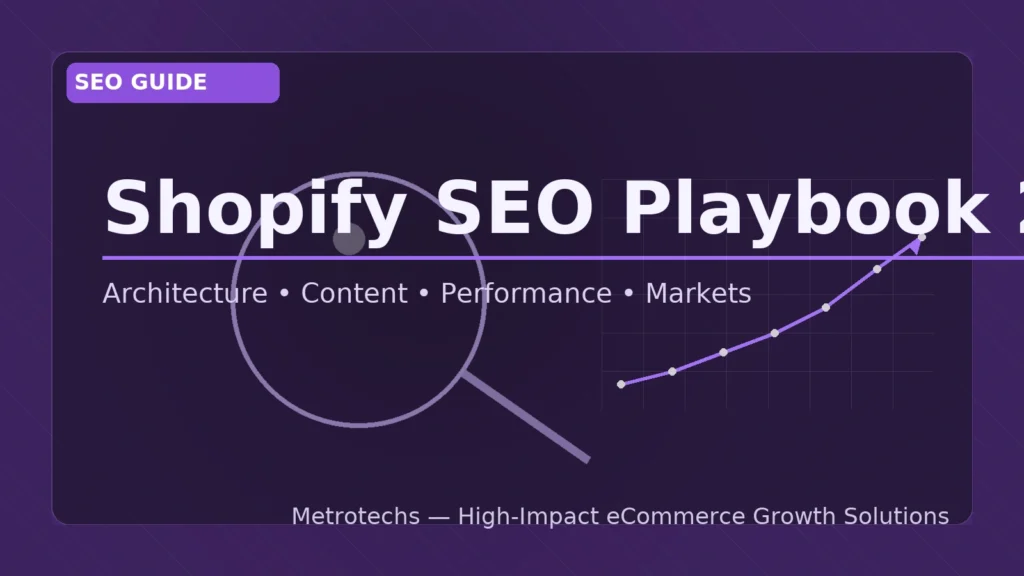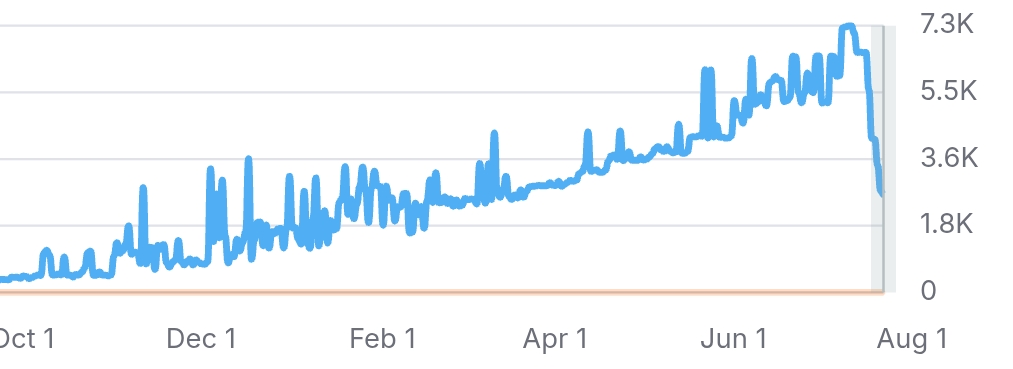If you run Shopify, SEO is one of the highest-leverage channels you control. This guide gives you a practical, up-to-date playbook you can implement today—no fluff, no “hacks,” just the systems that move rankings, traffic, and revenue.
1) Get the technical foundations right
Sitemaps. Every Shopify store auto-generates a sitemap at /sitemap.xml that lists products, collections, pages, and blog posts. Submit it in Google Search Console (GSC) and Bing Webmaster Tools, and re-submit after large launches or migrations.
Robots.txt. Shopify ships a sensible default. When you truly need exceptions (e.g., allowing a blocked crawler for a specific tool or disallowing a faceted path), add a robots.txt.liquid template and keep your overrides minimal so you retain Shopify’s automatic updates.
Canonical URLs. Shopify’s first-party themes output canonical tags by default. Keep them intact so collection-scoped product URLs (those that include /collections/.../products/...) canonicalize to the main product URL. Only override canonicals when you intentionally consolidate variants, filtered collections, or UTM’d pages.
301 redirects. Any time a handle changes, create a redirect in Content → Menus → URL redirects (or via API) so equity flows and users don’t hit 404s. Use CSV import for bulk changes and include these in any replatforming checklist.
“Hide from search” correctly. For pages that shouldn’t be indexed (e.g., temporary promos, thin tag archives), use a theme-level <meta name="robots" content="noindex,follow"> condition rather than blocking crawl paths that might also contain useful pages.
2) Architecture that scales (and ranks)
Accept the URL rules. You can edit the handle at the end of a URL, but you can’t remove core folders like /products or /collections. Don’t fight the platform—work with clean handles and rely on canonicals to de-duplicate “collection-scoped” product links.
Collections as landing pages. Treat top collections like evergreen category hubs:
-
Write a concise intro that targets the primary query.
-
Add internal links to key sub-collections or guides.
-
Keep filters crawl-friendly; avoid creating infinite combinations that index. (If you must expose filters, consider canonicals pointing to the base collection.)
Product detail pages (PDP). Own a unique primary keyword per PDP. Include:
-
Clear H1 (product name), persuasive meta title/description, unique copy beyond manufacturer text, FAQs, and spec tables.
-
Media that earns clicks in SERPs (multiple images, alt text, and review markup via your theme/app).
Internal linking. Use navigation, featured collections, “related products,” and editorial content to pass PageRank into money pages. Keep links descriptive (no “click here”).
3) Content that wins intent
Program a content plan. Shopify’s built-in blog is more than “news.” Build comparison posts (“X vs Y”), buying guides, size/fit help, use-case tutorials, and troubleshooting. Cross-link these to the exact collections and products that solve the problem.
Search-optimized templates. Standardize how you write meta titles (Primary keyword | Brand), H1s, first-paragraph summaries, schema, and internal links. Use bulk editors or apps for large catalogs to keep metadata fresh and consistent.
Structured data. Make sure your theme outputs JSON-LD for Products and Articles; Shopify provides a structured_data Liquid filter and many modern themes (e.g., Dawn) include schema by default. Validate with Rich Results Test.
4) Performance: Core Web Vitals without the rabbit hole
Measure what matters. Use Shopify’s Web Performance reports (which reflect Core Web Vitals) alongside Lighthouse. Don’t chase perfect scores; prioritize real UX—LCP, CLS, and TBT on your highest-traffic templates.
Let the CDN work. Upload high-quality images; Shopify will auto-compress and auto-serve WebP/AVIF where supported (with fallbacks). Size images correctly in theme code and avoid over-lazy-loading above-the-fold media.
Keep third-party bloat in check. Prefer Theme App Extensions (app blocks/embeds) you can toggle in the customizer, and routinely audit scripts. Each extra widget can add network and JS execution cost.
Speed score context. Shopify’s Online Store Speed aggregates Lighthouse across your top pages; use it as a trend line, not an absolute KPI. Test changes on a staging theme before shipping.
5) International & multilingual (Shopify Markets)
URL strategy comes first. Markets supports geo-targeted subfolders or domains. Pick a consistent structure (e.g., /en-us, /fr-ca) and stick with it.
Hreflang & sitemaps. When Markets and languages are configured, Shopify automatically adds hreflang tags and includes published languages in sitemaps—reducing duplicate-content risk across regions. Still verify in GSC and fix any mismatches.
Localize properly. Translate product content, menus, and URLs (slugs) for priority markets. Avoid automatic currency/language redirection that traps crawlers; give users a visible selector and let hreflang guide search engines.
6) Shopify SEO checklist (grab-and-go)
Every store
-
Submit
/sitemap.xmlto GSC & Bing; fix coverage errors monthly. -
Keep
robots.txt.liquidlightweight; block only true dead ends. -
Ensure canonicals output from theme; don’t remove them.
-
Audit redirects after launches/handle changes; import CSVs for bulk work.
-
Ship schema for Products/Articles; validate routinely.
-
Monitor Core Web Vitals; fix image sizing, script bloat, and layout shift.
Collections
-
One primary query per collection; SEO title/description unique.
-
100–200-word intro + curated internal links to sub-collections and guides.
Products
-
Unique copy (benefits, specs, FAQs), descriptive alt text, review markup.
-
Consolidate duplicate URLs via canonicals; prefer the plain
/products/handle.
Content
-
Publish guides and comparisons; interlink to the right SKUs/collections.
-
Use bulk tools to maintain titles/descriptions as the catalog evolves.
International
-
Decide subfolders vs. domains; verify properties in GSC per market.
-
Check hreflang in page source and in “International targeting” reports.
7) Common Shopify SEO pitfalls (and fixes)
-
Endless filtered URLs indexing. Fix: Canonical to the base collection; consider
noindex,followfor tag archives you don’t want in results. -
Changing handles without redirects. Fix: Always add 301s; keep a migration sheet.
-
Over-aggressive lazy-loading. Fix: Don’t lazy-load hero media; reserve it for below-the-fold images.
-
Bloated apps/scripts. Fix: Remove unused apps, disable embeds you aren’t using, and consolidate trackers.
8) Reporting & iteration
-
Track organic sessions, revenue, and assisted conversions by page type (collection, product, article).
-
Review GSC for new queries and coverage issues; expand winners with supporting content and internal links.
-
Re-run Lighthouse on your staging theme after meaningful theme/app changes.
Closing thought
Shopify gives you robust defaults—clean sitemaps, sensible canonicals, a fast CDN, and scalable architecture. Your edge comes from disciplined information architecture, thoughtful content, and a lightweight, measurable storefront.
Research sources
-
Shopify Help Center – SEO: overview, sitemaps, robots, site structure. Shopify Help Center
-
Shopify Dev Docs – robots.txt.liquid and customization. Shopify
-
Shopify – Canonical URLs best practices (blog). Shopify
-
Shopify Help Center – URL redirects (admin & CSV); Admin API Redirect. Shopify Help Center Shopify
-
Shopify Help Center – Web Performance reports; Shopify on speed score/Lighthouse. Shopify Help Center Shopify
-
Shopify CDN & images – upload quality, AVIF/WebP delivery, product media. Shopify Help Center Shopify
-
Shopify Markets – international domains, languages, and hreflang automation. Shopify Help Center
-
Shopify community clarification – URL structure limits (handles vs. folders). Shopify Community





